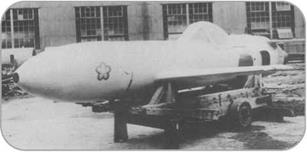German and Japanese Innovations
The V-1 was one of several innovative weapons developed by the Germans. These included the V-2 ballistic missile, anti-aircraft missiles, guided bombs, and the rocket-powered Me-163 interceptor, capable of speeds of 620 miles per hour (1,000 kilometers per hour). The Dornier Do-335 Pfeil “Arrow” was a twin-engine fighter, with one propeller in its nose and another in its tail. This unique airplane was almost as fast as a jet, but only a handful reached the Luftwaffe before the war ended.
The Germans were the first to use remote-guided rockets, in 1943, firing HS-293 missiles against British ships
KAMIKAZE MISSIONS
As the war swung against Japan, the nation resorted to kamikaze attacks, which started in October 1944. The word kamikaze means "divine wind." Volunteer pilots crash-dived their planes packed with explosives onto U. S. Navy ships, killing themselves and creating as much destruction as possible. Japan even built a rocket-powered suicide plane, the Ohka, which was launched from a carrier plane. An estimated 3,000-4,000 pilots flew kamikaze missions for Japan, sinking between thirty and eighty U. S. ships and damaging many more.
|
о Jet engines and rockets both advanced during the course of World War II, as scientists rushed to develop new and lethal instruments of war. The Japanese Ohka suicide plane, shown here, used rocket and jet technology. |
in the Atlantic Ocean. Similar radio – controlled missiles, air-launched from Dornier 217 bombers, sank the Italian battleship Roma following Italy’s surrender to the Allies in 1943.
The Japanese proved resourceful in building robust fighting airplanes, such as the Mitsubishi Zero. The Japanese, like the Germans, had no long-range heavy bombers, but in 1944 they did attack the West Coast of the United States by flying balloons carrying small bombs across the Pacific. About 9,000 balloons were launched; around 1,000 reached the United States, causing 285 recorded incidents and six deaths.











